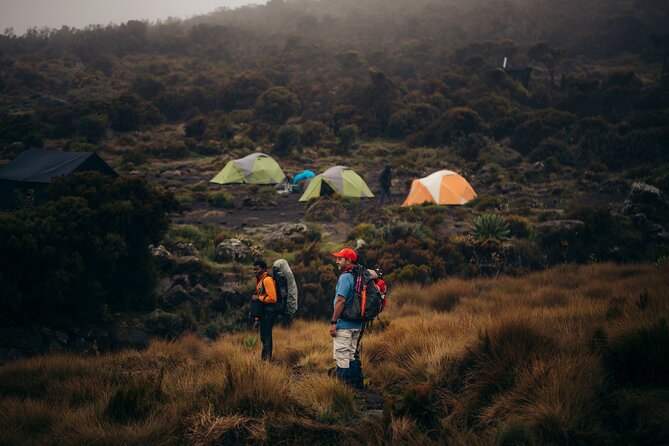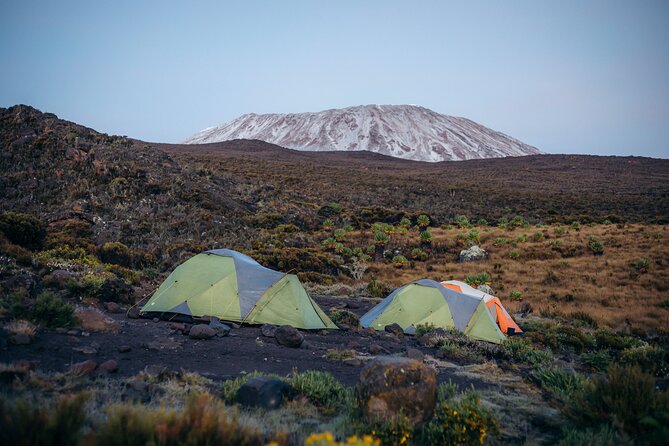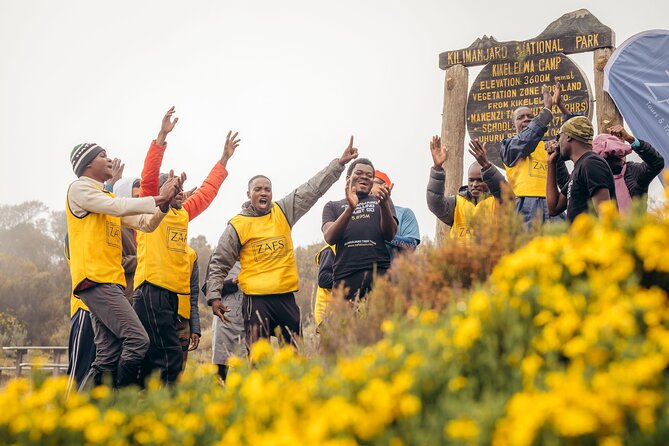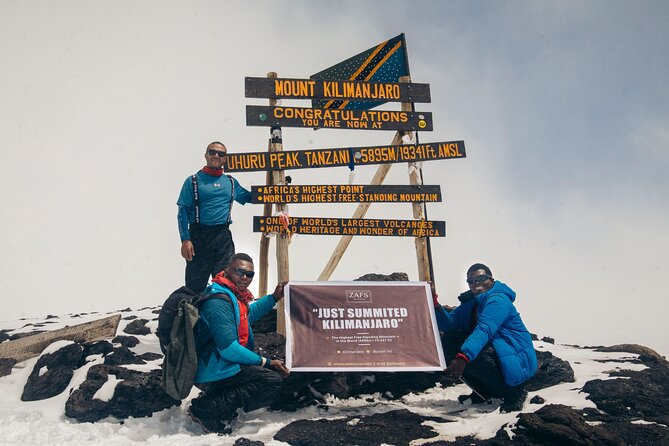Scaling the majestic peaks of Kilimanjaro through the challenging yet captivating Machame route is a true test of endurance and resilience. Spanning a distance of 56 kilometers over the course of seven days, this trek offers trekkers a unique opportunity to enjoy the diverse landscapes and ecosystems of Tanzania’s iconic mountain. From lush rainforests to barren volcanic terrain, the Machame route presents a multifaceted adventure that not only pushes the boundaries of physical capabilities but also promises a deeply rewarding sense of accomplishment. As you embark on this extraordinary journey, prepare to be captivated by the beauty and grandeur of Kilimanjaro, while navigating the challenges that lie ahead.
Key Points

- The Machame Route is a 56-kilometer trek spanning 7 days, traversing diverse landscapes and reaching the summit at Uhuru Peak (5,895 meters).
- Accommodations include private tents, a dining tent, and necessary equipment for a comfortable camping experience.
- Freshly prepared meals, including breakfast, lunch, and dinner, are served daily, catering to special dietary requirements.
- An experienced mountain crew, comprising guides, a chef, a waiter, and porters, provides expertise in navigation, safety, and local culture.
- The trek begins with a pickup from the Moshi Leopard Hotel, and clients are returned to the same location upon completion.
Overview of the Machame Route

The Machame Route, also known as the ‘Whiskey Route,’ is one of the most popular and challenging routes for climbing Kilimanjaro, Africa’s highest mountain.
Spanning a total distance of approximately 56 kilometers (35 miles) over the course of 7 days, this route takes trekkers through diverse landscapes, including dense rainforests, alpine meadows, and rugged volcanic terrain, before reaching the summit at Uhuru Peak, standing tall at 5,895 meters (19,341 feet) above sea level.
The route is renowned for its stunning vistas, with hikers often being rewarded with breathtaking views of the surrounding peaks and glaciers.
However, the Machame Route is also considered one of the more strenuous routes, requiring a good level of physical fitness and endurance to complete successfully.
Here are more great tours and experiences we've reviewed in Moshi
Accommodations and Camping Equipment

On the Machame Route, pre and post hike accommodation in Moshi is available on request to provide travelers with a comfortable base before and after their Kilimanjaro expedition.
The camping equipment provided includes private tents, a dining tent, tents for the crew, tables, chairs, mattresses, as well as all necessary cutlery and utensils. This ensures a restful and well-equipped camping experience throughout the trek.
The private tents offer a cozy and secure space for each participant, while the dining tent serves as a communal area for enjoying the freshly prepared meals. The additional crew tents, furniture, and kitchen essentials create a fully-supported camping setup to make the journey as comfortable and enjoyable as possible.
Meals and Dining Experience

Freshly prepared meals are served daily on the mountain, including breakfast, lunch, and dinner, providing climbers with the necessary sustenance to tackle the challenging terrain.
A selection of coffee and/or tea accompanies these wholesome repasts, ensuring that participants remain energized throughout the trek.
The dining tent serves as a communal space for savoring these meals, fostering a sense of camaraderie and shared experience among the trekking group.
Meals are expertly crafted by the expedition’s skilled chef, using local ingredients to offer a taste of Tanzanian cuisine.
Special dietary requirements can be accommodated with advance notice, ensuring that each climber’s nutritional needs are met.
The dining experience on the Machame Route is designed to fuel the body and nourish the spirit, contributing to a successful and memorable Kilimanjaro ascent.
Experienced Mountain Crew
Accompanying climbers on their Kilimanjaro expedition is an experienced and capable mountain crew, comprising skilled guides, a dedicated chef, an attentive waiter, and a team of hardworking porters.
These individuals are integral to the success of the journey, drawing upon their extensive knowledge of the terrain, weather patterns, and local culture to ensure a safe and rewarding ascent.
The guides, with their expertise in navigation and mountain safety, lead the way, while the chef and waiter work tirelessly to prepare nourishing meals and ensure a comfortable dining experience.
The porters, responsible for carrying the necessary equipment and supplies, play a vital role in supporting the group throughout the demanding trek.
This experienced team works seamlessly to create an exceptional Kilimanjaro adventure.
Meeting and Pickup Details

The climbing expedition begins with a pickup from the Moshi Leopard Hotel, where you will assemble before the start of the journey.
Clients are required to arrive at the designated meeting point by 12:00 am, as the group will depart promptly at this time to begin the trek up Kilimanjaro’s Machame Route.
This early start is necessary to ensure that the group can cover the required distance and reach the first campsite before nightfall.
Upon completion of the trek, clients will be returned to the original meeting point at the Moshi Leopard Hotel.
Clear communication and punctuality are essential for a successful and seamless start to the Kilimanjaro adventure.
Packing Essentials for the Hike

Proper packing for the Kilimanjaro hike is essential to ensure a comfortable and successful ascent. Climbers should bring a well-rounded selection of cold-weather gear, including base layers, insulating mid-layers, and weatherproof outer shells to protect against the mountain’s notoriously unpredictable conditions. To help guide your packing, consider the following essentials:
| Item | Quantity |
|---|---|
| Hiking boots | 1 pair |
| Trekking poles | 1 pair |
| Thermal underwear | 2-3 sets |
| Warm jacket | 1 |
| Waterproof jacket and pants | 1 set |
| Water bottles/hydration system | 2-3 liters |
| Headlamp | 1 |
| Sunglasses | 1 pair |
| Sunscreen and lip balm | 1 of each |
Pre and Post Hike Arrangements

Prior to and following the hike, accommodations can be arranged in Moshi upon request. These pre- and post-hike lodgings provide a comfortable and convenient base for travelers, allowing them to rest, prepare, and debrief surrounding their Kilimanjaro expedition.
The on-site accommodations feature private tents, dining tents, and other essential camping equipment, ensuring a pleasant and well-equipped experience. Plus, the package includes daily freshly prepared meals, as well as coffee and tea, to fuel adventurers throughout their journey.
With experienced guides, chefs, waiters, and porters supporting the climb, climbers can focus on the challenge ahead while having their logistical needs seamlessly handled.
Reasons to Choose the Machame Route
Why is the Machame Route a popular choice for climbing Kilimanjaro?
This route offers several advantages that make it a compelling option for adventurous climbers.
Firstly, the Machame Route provides a scenic and diverse ascent, allowing hikers to traverse through various ecological zones, from lush rainforests to barren alpine deserts, offering a visually captivating journey.
Plus, the gradual elevation gain and carefully designed trail system of the Machame Route are designed to maximize the chances of successful summit attempts, making it a prudent choice for those seeking to reach the roof of Africa.
The route’s length of seven days also allows for better acclimatization, further increasing the likelihood of reaching the summit safely.
Frequently Asked Questions
What Is the Best Time of Year to Climb Kilimanjaro?
The optimal time to climb Kilimanjaro is during the dry seasons of January to March or June to October. These periods offer the most favorable weather conditions, with clear skies, minimal precipitation, and moderate temperatures, making the trek more comfortable and safer for climbers.
Can I Bring My Own Hiking Gear or Is It Provided?
Clients have the option to bring their own hiking gear or use the equipment provided by the tour company. The tour provides camping equipment, including private tents, dining tent, and other necessary gear for the trek.
How Difficult Is the Machame Route Compared to Other Routes?
The Machame route is considered one of the more challenging routes on Kilimanjaro, with steeper ascents and more technical sections compared to other routes. It requires a good level of physical fitness and hiking experience to successfully complete the trek.
What Is the Success Rate for Summiting Kilimanjaro on This Route?
The success rate for summiting Kilimanjaro on the Machame route is typically around 85-90%. This popular route offers a gradual ascent and multiple acclimatization days, which contributes to its high success rate compared to other routes. However, proper preparation and fitness remain crucial for a successful summit.
Can I Extend the Hike for More Acclimatization Days?
Yes, it is possible to extend the hike for more acclimatization days on the Machame route. Extending the hike allows for a slower ascent, which can increase the likelihood of successful summit attempts by improving the body’s ability to adapt to the higher altitude.
Recap
The Machame route on Kilimanjaro offers a challenging yet rewarding trekking experience.
Diverse landscapes, comfortable camping facilities, and a skilled mountain crew ensure an enjoyable journey to the summit of Uhuru Peak.
The route’s well-equipped nature and pre/post-hike arrangements make it an attractive choice for those seeking a comprehensive Kilimanjaro climbing experience.
More 7-Day Experiences in Moshi
More Tour Reviews in Moshi
Not for you? Here's more things to do in Moshi we have recnetly reviewed
- 7 Days Mid Range Tanzania Wildlife Safari
- Private Multi Day Safari Tour in Tanzania
- Private Kilimanjaro Hike 7 Day Lemosho Route
- 1-Day Moshi Villages Bike Tour
- Chemka Hotsprings
- 6-Days Mt. Kilimanjaro Bike Trek -With- BURIGI CHATO SAFARIS CO L.T.D
- 7 Days Lemosho Route Kilimanjaro Climbing | Solely Tours
- West Kilimanjaro Cycling Adventures
- 8 Days Lemosho Route Climbing Mt. Kilimanjaro
- Moshi City Bike Day Trip
- The Best 7 Days Kilimanjaro Hiking Machame Route in & 2025
- 6 Days Tanzania Budget Camping Safari With Migration
